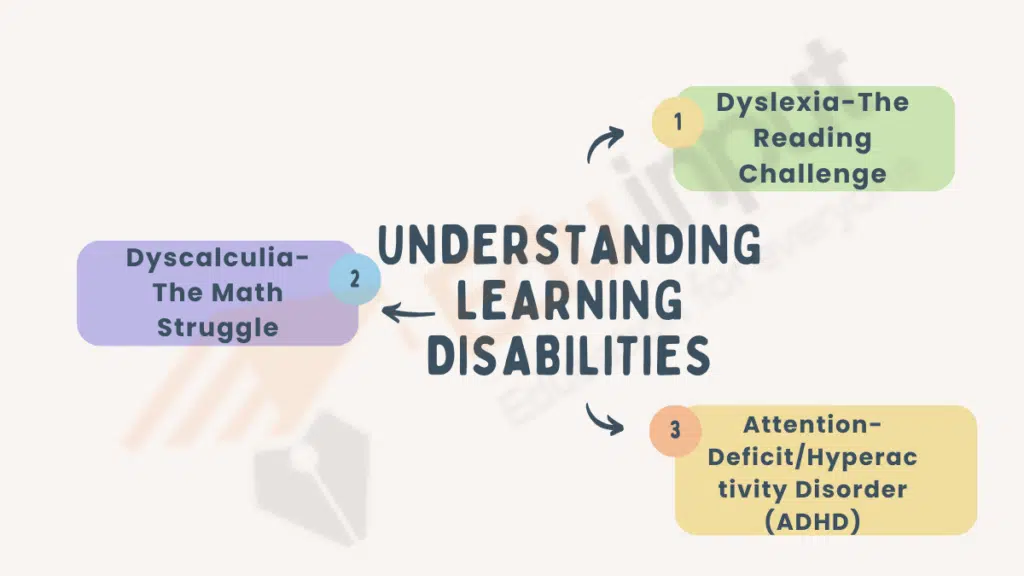Examples of Learning Disabilities in Students
Learning disabilities are a diverse range of disorders that can affect a student’s ability to learn and process information. These disorders can make it difficult for students to read, write, do math, and learn in other ways.
Learning disabilities can be challenging for students, but they can be overcome with the right support.
Students with learning disabilities can succeed in school and in life with the help of teachers, parents, and other professionals.
In this we will discuss some examples of learning disabilities.

Understanding Learning Disabilities

1: Dyslexia-The Reading Challenge
Dyslexia is perhaps one of the most widely recognized learning disabilities. Students with dyslexia struggle with reading, spelling, and decoding words.
Despite their intelligence and creativity, they may find it difficult to recognize written words, which can significantly hinder their academic performance.
2: Dyscalculia-The Math Struggle
Dyscalculia is another prevalent learning disability. Students with dyscalculia face difficulties in understanding and manipulating numbers.
Basic math operations, such as addition, subtraction, multiplication, and division, can pose substantial challenges for them.
3: Attention-Deficit/Hyperactivity Disorder (ADHD)
While not exclusively a learning disability, ADHD can greatly affect a student’s ability to concentrate and learn.
Students with ADHD may find it challenging to focus on tasks, follow instructions, and manage their time effectively, making it difficult for them to excel academically.
Language-Based Learning Disabilities

1: Auditory Processing Disorder (APD)
APD affects a student’s ability to process and make sense of auditory information.
Students with APD may struggle with following verbal instructions, comprehending spoken language, or distinguishing between similar-sounding words.
2: Language Processing Disorder (LPD)
LPD interferes with a student’s ability to comprehend and use language effectively.
This includes difficulties in understanding idioms, figurative language, and complex sentence structures, making it challenging for them to excel in language-intensive subjects.
Visual and Motor-Based Learning Disabilities

1: Visual Processing Disorder
Students with visual processing disorders may have trouble interpreting visual information.
This can manifest as difficulties in recognizing shapes, patterns, or spatial relationships, impacting subjects like geometry or art.
2: Dysgraphia-The Writing Challenge
Dysgraphia affects a student’s ability to write legibly and coherently.
They may struggle with handwriting, spelling, and organizing their thoughts on paper, which can hinder their performance in written assignments.
Other Learning Disabilities
1: Executive Function Disorder
This disorder can affect a student’s ability to plan, organize, and complete tasks. It often leads to difficulties in time management, prioritization, and goal setting.
2: Non-Verbal Learning Disabilities (NVLD)
NVLD primarily impacts a student’s social skills and spatial awareness.
These students may struggle with understanding non-verbal cues, which can affect their interactions with peers and teachers.
Learning disabilities are not a reflection of a student’s intelligence but rather a unique challenge they face in their academic journey.
Recognizing these challenges and providing appropriate support and accommodations is crucial to help these students thrive.
FAQs
Can students with learning disabilities succeed academically?
Absolutely! With the right support, accommodations, and a nurturing learning environment, students with learning disabilities can excel academically and reach their full potential.
How can teachers identify students with learning disabilities?
Teachers can identify students with learning disabilities through careful observation, assessments, and collaboration with special education professionals. Early intervention is key.
Are learning disabilities permanent?
While learning disabilities are typically lifelong, early intervention and effective strategies can help individuals manage their challenges and succeed in school and beyond.
What are some common accommodations for students with learning disabilities?
Common accommodations include extended time on tests, preferential seating, access to assistive technology, and modified assignments tailored to the student’s needs.
How can parents support a child with a learning disability?
Parents can support their child by working closely with educators, advocating for their child’s needs, providing a structured and supportive home environment, and offering emotional support and encouragement.



Leave a Reply